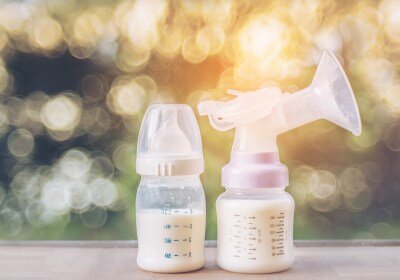
keep it cool: storing breast milk
Having breast milk stashed away is incredibly helpful and often quite reassuring knowing there is a supply to fall back on. How you store your milk is going to entirely depend on when you will be using it. Whether you chose to fridge or freeze, there are some basic principles to breast milk storage that you should consider first.
Sterile Containers
Make sure you have containers that are appropriate to store your milk in. These can be plastic bottles / tubs, or breast milk storage bags. The storage bags will come sterile, but the tubs and bottles will need to be clean and sterile. Chose containers that will fit easily into your fridge and freezer, that can be stacked and wont be damaged by freezing or cleaning.
Label
Make sure your containers are labeled with the date and time of when you expressed the milk. This ensures it can be used in a chronological order and avoids waste. It also means that you can identify milk from certain time periods. This is important as sometimes a baby’s feeding requirements change, you may need to start cutting dairy out for example; if you have milk expressed from before these changes were made, then you might wish to hold off giving them to your baby unless wanting to re challenge.
Prepare to pump
There are certain things you will want to do prior to expressing breast milk. The main being, wash your hands, and make sure your pump is clean and sterile.
Storage
Room temperature
Milk can be kept at room temperature, no more than 25 degrees C, for up to six hours. This is useful if you’re out and about, or if your baby is fussy feeding, little and often. It allows you to keep a regimented pumping schedule (if you wish), but demand feeding your baby. You can also use a cool box packed with ice to store your milk for up to 24 hours. This is handy for going on a journey if don’t want to express when travelling but need a supply for feeding on the day.
Fridge
Breast milk should be kept at the back of the fridge and not in the door. It can be stored in a fridge that is four degrees C or colder for up to eight days and should be kept away from raw foods and eggs. You can also keep your breast milk in the freezer box of the fridge for up to two weeks.
You can add all the milk you express in one day into one container if you wish but you need to ensure that the milk you are adding is cooled first, before mixing with the cooled fridge milk. You can’t add warm or room temperature milk to cold milk; cold into cold. If you do combine milk from different pumping sessions into one container, you can only store it until the oldest/first volume expires. So, don’t go adding freshly expressed milk to four day old milk as you are just going to have to use ASAP.
Freezer
If kept at minus 18 degrees or lower, breast milk can be stored for up to six months. If you are planning on freezing milk do it as soon as possible. Make sure you don’t fully fill your container as frozen milk will expand and likely damage the container. Plastic breast milk storage bags can tear, which you will notice when thawing, or when you find frozen breast milk all over your freezer drawer and stuck to your fish fingers!
Frozen milk is best thawed in the fridge and stored for 12 hours. If you need it faster then you can pop the container in warm water to bring up to room temperature. Never refreeze breast milk.
Freezing top tip: you can use ice cube trays (with a lid) to store small quantities of breast milk. These cubes defrost super quick and are good for an S.O.S. moment!
